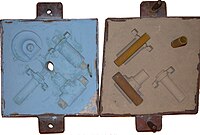
Photo from wikipedia
In the compaction process, an uneven densification of the powder through the entire height of the die is a major problem which determines the strength properties of the final product,… Click to show full abstract
In the compaction process, an uneven densification of the powder through the entire height of the die is a major problem which determines the strength properties of the final product, which vary throughout the entire volume. The aim of this investigation was to determine the distribution of the forming pressure inside the die and to visualise the differences in compaction. To determine the pressure inside the die during the compaction process, the deformation on the die surface was measured by means of strain gauges. However, in order to visualise the densification of high-silica sand during the compaction process, an X-ray tomograph was used, which permits one to visualise the interior of the die. The authors developed an analytical model of how the change in internal pressure influences the change in stresses arising on the outer surface of the die, and, as a result, the friction force. It has been observed that the highest values of pressure as well as the highest concentrations of the loose medium are found closest to the punch and decrease with distance from the punch. Moreover, based on the measurements of deformation, a dependence of the pressure distribution on the value of friction forces was observed, which prompted further analysis of this phenomenon. As a result, tests to determine the coefficient of friction between the die and the loose medium were carried out. This made it possible to describe the pressure distribution inside the die, based on the pressure applied and the height of the die.
Journal Title: Materials
Year Published: 2022
Link to full text (if available)
Share on Social Media: Sign Up to like & get
recommendations!